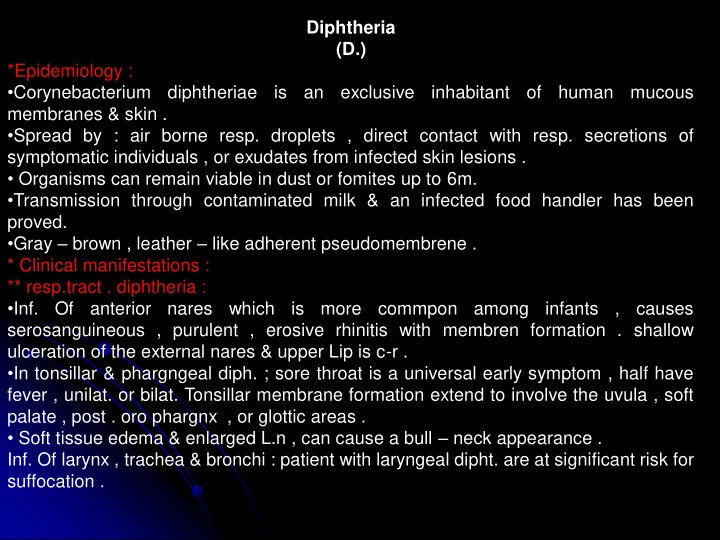

Diphtheria (D.) *Epidemiology : • Corynebacterium diphtheriae is an exclusive inhabitant of human mucous membranes & skin . • Spread by : air borne resp. droplets , direct contact with resp. secretions of symptomatic individuals , or exudates from infected skin lesions . • Organisms can remain viable in dust or fomites up to 6m. • Transmission through contaminated milk & an infected food handler has been proved. • Gray – brown , leather – like adherent pseudomembrene . * Clinical manifestations : ** resp.tract . diphtheria : • Inf. Of anterior nares which is more commpon among infants , causes serosanguineous , purulent , erosive rhinitis with membren formation . shallow ulceration of the external nares & upper Lip is c-r . • In tonsillar & phargngeal diph. ; sore throat is a universal early symptom , half have fever , unilat. or bilat. Tonsillar membrane formation extend to involve the uvula , soft palate , post . oro phargnx , or glottic areas . • Soft tissue edema & enlarged L.n , can cause a bull – neck appearance . Inf. Of larynx , trachea & bronchi : patient with laryngeal dipht. are at significant risk for suffocation .
** Cutaneous dipht. : Is an indolent , non progressive , infection c.r. by asuperficial , ecthymic , non healing ulcer . ** infection at other sites : ear , eye , genital tract . * diagnosis : Culture of the specimens from nose & throat p& mucocutaneous Lesion . * Toxic cardiomyopathy : 10 – 25% of patients . First evidence c.r. occurs during 2nd & 3rd wk. of illness , as pharyngeal dis. Improves . Tachycardia out of proportion to fever is common . Prolonged PR interval & changes in the ST – T wave on ECG . First , 2nd & 3rd degree heart block . H.F. may appear insidiously or actuely . Recovery is usu. Complete.
* Prognosis : Virulence of organism , P. age , immunization status , site of infection , speed of administration of antitoxin . * Prevention : Vacc. * Asymptomatic contacts : -Antimicrobial prophylaxsis : using ergthromycin 40 – 50 mg /kg/d. , divided qid Po for 7d. or single inj. of Beng. Penicillin G. - Dipht. toxoid vacc. , who not received abooster dose within 5y. * Asymptomatic carriers : - Antimicrobial prophylaxsis is given for 7d. - Toxoid if abooster has not been given within 1y .
* Toxic Neuropathy : Occur acutely or 2 – 3 wk. Local paralysis of soft palete occur . Weakness of post. Pharyngeal , laryngeal & Facialn . Risk for aspiration. Symmetric polyneuropathy lod – 3m. Distal M. Weakness. Complete nerologic recovery is likely . * Treatment : 1. Antitoxin : 20.000 – 120.000 u. 2. Antimicrobal therapy : - erythromycin : 40 – 50 mg / Kg /d. , divided every 6hr. Po or I.V. - Aqueous crystalline penicillin 100.000 – 150.000 U/kg/d. or orocaine pencillin 250.000 – 50.000 u/kg/d . * Therapy is given for 14 days . 3. bed rest : usu. For ≥ 2wk. until the risk for symptomatic cardiac damage has passed .
Diphtheria (D.) * epidemiology : Corynebacterium diphtheriae is an exclusive inhabitant of human mucous membranes & skin . Spread by : air borne resp. droplets , direct contact with resp. secretions of symptomatic individuals , or exudates from infected skin lesions . Organisms can remain viable in dust or fomites up to 6m. Transmission through contaminated milk & an infected food handler has been proved . gray – brown , leather – like adherent pseudomembrene . * Clinical manifestations : ** Resp.tract . diphtheria : inf. Of anterior nares which is more common among infants , causes serosanguineous , purulent , erosive rhinitis with membren formation . shallow ulceration of the external nares & upper Lip is c.r. in Tonsillar & pharyngeal diph. ; sore throat is a universal early symptom , half have fever , unilat. or bilat. tonsillar membrane formation extend to involve the uvula m soft palete , post . oro pharynx , or glottic areas . soft tissue edema & enlarged L.n , can cause a bull – neck appearance . inf. Of larynx , trachea & bronchi : patient with larynheal dipht. are at significant risk for suffocation .
** cutaneous dipht. : Is an indolent , non progressive , infection c.r. by a superficial , ecthymic , non healing ulcer . ** infection at other sites : Ear , eye , genital tract . * diagnosis : Culture of the specimens from nose & throat & mucocutaneous lesion . ** complications : Toxic cardiomyopathy : 10 – 25% of patients . First evidence c.r. occurs during 2nd & 3rd wk. of illness , as pharyngeal dis. Improves. Tachycardia out of proportion to fever is common . Prolonged PR interval o& changes in the ST – T wave on ECG. First , 2nd & 3rd degree heart block . H.F.may appear inosidiously or actuely . Recovery is usu. Complete . Toxic Neuropathy : Occur acutely or 2 – 3 wk. Local paralysis of soft palete occur . Weakness of post. Pharyngeal , laryngeal & facial n. Risk for aspiration . Symmetric polyneuropathy 10 d – 3m . Distal M. weakness . Complete nerologic recovery is likely .
Recommend
More recommend